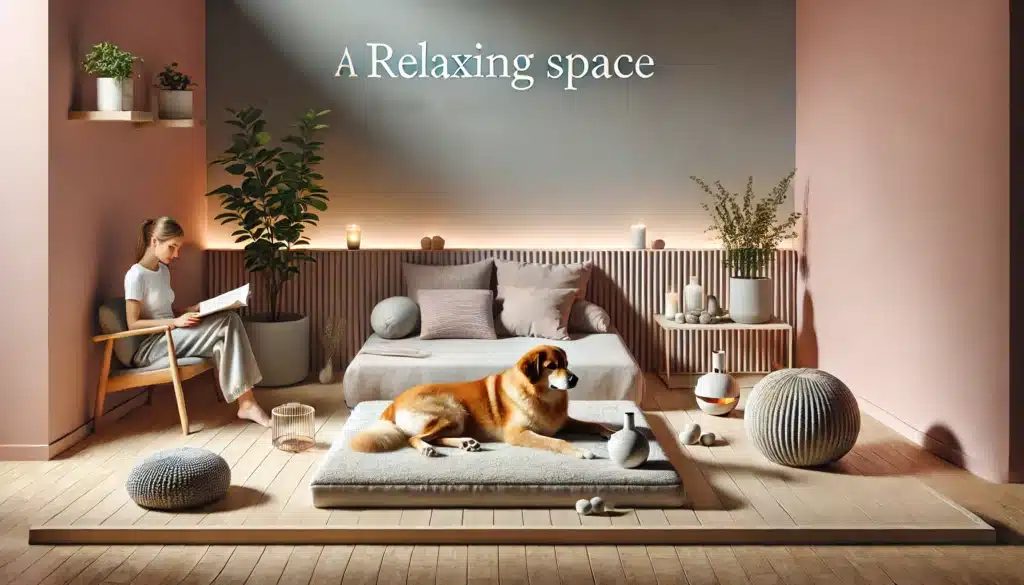Just like people, dogs need a space where they can unwind, recharge, and feel completely at ease. A dedicated relaxation zone helps your dog manage stress, sleep better, and regulate emotions — especially in noisy or busy households.
In this guide, you’ll learn how to create a calm, cozy space that supports your dog’s mental and emotional well-being, whether you live in a house, an apartment, or somewhere in between.
Why Dogs Need a Calm Space
A relaxing area gives your dog a safe, predictable place where they can:
- Retreat from overstimulation (loud noises, guests, children)
- Self-soothe during anxiety
- Get better rest and sleep
- Learn to settle calmly
- Reduce hyperactivity or attention-seeking behavior
Creating this space helps dogs feel more secure and confident, especially during stressful moments like storms, fireworks, or unfamiliar visitors.
Step 1: Choose the Right Location
The ideal spot is:
- Quiet and low-traffic
- Away from loud appliances or windows
- Close enough to feel safe — but not overwhelmed
- Not used for punishment or isolation
🏠 Good options:
- A corner of your bedroom or living room
- A spare room or home office
- Under a staircase or behind a couch
- A walk-in closet with ventilation and soft lighting
Let your dog show you where they naturally like to rest — many will gravitate toward cozy corners already.
Step 2: Add a Comfortable Rest Surface
Whether it’s a bed, mat, or crate, your dog needs a soft, supportive surface to relax on.
🛏️ Options:
- Bolster bed for dogs that like support
- Flat mat for hot climates or sprawlers
- Orthopedic bed for seniors or large breeds
- Crate with open door and soft blankets
Pro tip: Add a blanket or shirt that smells like you for extra comfort and security.
Step 3: Control Light, Noise, and Stimulation
A calm environment is about reducing input from the outside world.
🕯️ How to create calm:
- Use curtains or shades to block visual distractions
- Play white noise or soft classical music
- Use dimmable lights or natural daylight when possible
- Avoid TVs, loud music, or shouting near the space
- Use a pet-safe diffuser with calming scents (lavender, chamomile)
Some dogs may benefit from a covered crate or canopy to simulate a den.
Step 4: Keep It Scent-Safe and Clean
Dogs have incredibly sensitive noses — a relaxing space should smell pleasant and familiar.
- Wash bedding weekly
- Use unscented or pet-safe cleaners
- Avoid strong air fresheners or sprays nearby
- Add natural calming sprays or pheromone diffusers (like Adaptil)
Important: Never use essential oils directly on your dog without veterinary guidance.
Step 5: Include Calming Activities
Your dog’s calm zone can also be a space for quiet enrichment.
🧘 Calm-time tools:
- Lick mats with peanut butter or yogurt (xylitol-free)
- Snuffle mats for gentle sniffing games
- Frozen Kongs for slow chewing
- Chew-safe bones or bully sticks
- Gentle brushing sessions (if your dog enjoys it)
These activities help your dog release energy without overstimulation.
Step 6: Use Positive Association
You want your dog to see this space as a safe retreat, not a place of isolation or punishment.
- Reward them when they choose to rest there
- Practice the cue “Place” or “Go to bed” with treats
- Give praise and affection for calm behavior
- Never force them into the space or close them in unless it’s for rest
Over time, your dog will naturally return to the space when they need a break.
Step 7: Make It a No-Kid, No-Stress Zone (If Needed)
If you live with children or multiple pets, teach everyone to respect the dog’s space.
- Use a visual cue like a sign: “Dog Resting Zone”
- Don’t allow playtime, loud noises, or toys in this area
- Explain to kids: “When the dog is here, we give them quiet time”
Boundaries help your dog truly relax — and teach everyone in the home about respect and empathy.
Step 8: Adapt the Space to Your Dog’s Personality
Every dog is different. What relaxes one dog might bore or stress out another.
🐶 Examples:
- Nervous dogs may prefer enclosed crates
- Confident dogs might enjoy open beds near you
- Seniors may need elevated beds with orthopedic support
- Puppies often relax better with chewable toys and familiar scents
Observe your dog and adjust the space to suit their preferences over time.
Bonus Tips for Extra-Calm Environments
- Try a cooling mat if your dog runs hot
- Use calming music playlists for dogs (available on Spotify or YouTube)
- Create a daily “calm time” routine, where your dog goes to their spot with a treat after meals or walks
- Combine with a light massage or brushing session to deepen relaxation
Final Thoughts: Every Dog Deserves a Peaceful Place
Creating a relaxing space for your dog is one of the best ways to support their emotional health. It’s a quiet message that says: “You’re safe here. You can rest.”
Whether it’s a cozy corner, a crate with soft bedding, or a sunny spot by the window, your dog will learn to associate that place with peace, comfort, and trust — and in return, you’ll have a calmer, more balanced companion.
Because a peaceful dog starts with a peaceful space.







